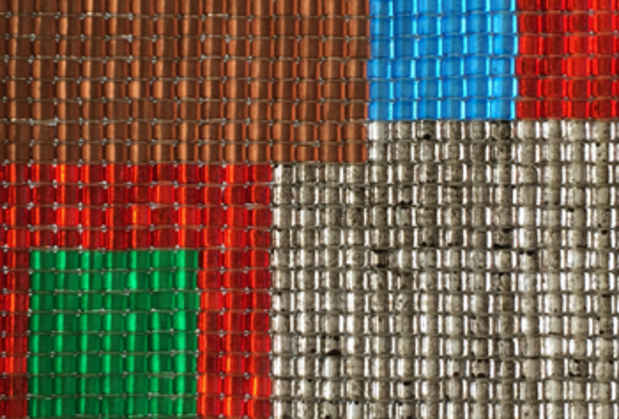“Loominosity” Exhibition
OUTLET

This event has ended.
The most recent installation at OUTLET gallery features six artists who use the loom as their primary creative tool: Samantha Bittman, Amanda Hu, Robin Kang, Steven and William Ladd, Erin M. Riley, and Phillip Stearns. The artists employ a variety of material in their work, including silk, wool, and cotton threads, as well as glass beads and metallic materials. Their work is in conversation with a long tradition of textile artists who approached textile as fine art. The early weavings of Anni Albers and Gunta Stölzl are rich and beautiful examples of textile fine art. Their pieces were created at the Bauhaus during the 1920s, incorporating avant-garde, formal design ideas with an exploration of new weaving materials such as cellophane. With the current focus on digital technology in art and the prevalence of daily media stimuli, the history of the loom and its relationship to early computing machines is a relevant consideration for contemporary artists and the six artists in Loominosity dialog with this complex history by using the loom to create unique perspectives.
Samantha Bittman is a Chicago based painting and textile artist who uses traditional over-and-under warp-and-weft interlacements to create geometric patterns that reference minimalist painting, while still revealing the trace of her hand. The manually woven structures are sometimes used as a sub-structure for her paintings, allowing the textile’s forms to dictate the shapes and composition of the painting. The handmade, subjective quality of her woven designs are contrasted with the rigid tradition of straight edged abstraction. Bittman is inspired by the inherent limitations of the loom’s mechanics and finds her own systems and modes of expression within these parameters.
Amanda Hu is a New York based mixed media artist with expertise in printmaking, paper-making, book arts and, more recently, woven textile art. Her most recent work references ocean landscapes and possess some of the sublime qualities of James Whistler’s expansive seascape paintings. She is particularly drawn to images of the seascape horizon at twilight when the sea becomes a reflection of the sky at sunset that seem to disappear into infinity. Hu’s delicate use of color and nuanced choice of fibers create gorgeous textures that engage the viewer in a meditative way.
In contrast to these, the most recent Jacquard loom-produced textiles by Robin Kang use harder edges and a technology-based sensibility. Using memory chips and circuit boards as her source of inspiration, Kang creates complex digital designs that are translated into her woven structures. She combines the spray brush gestures in Photoshop with symbols from Pre-Columbian weaving traditions, as well as motherboard hardware, into the interlocking threads. Simulating industrial production through repetition and pattern creation, she immerses herself in the history of rich connections between textiles and electronics.
The Manhattan-based brothers Steven and William Ladd have collaborated for the last fourteen years using design, textile, sculpture, jewelry, performance, and video to create objects that communicate a deeply personal vision. Their unique process is informed largely by personal narratives, which are reinterpreted in both abstract and symbolic forms. Their woven tapestries are made on a hand-built loom with colored glass beads. The sensual glass beaded panels can be used to divide space or as a wall tapestry, delivering a rich aesthetic and a transcendent visual experience.
Erin M. Riley is a Brooklyn-based tapestry artist who sources her images from thousands of ‘selfies’ of young, sexualized women on social media websites. Riley intends her work to celebrate female sexual exploration and empathizes with the desire for acceptance, while acknowledging the darker realities of male objectification and the loss of innocence. She uses a traditional floor loom and hand-dyed wool to create beautiful, laboriously woven tapestries, completely contrary to the immediacy of their digital origins. There is a strange and unsettling relationship in her works between the wholesome, historical notion of women working on looms in their homes and the contemporary notion of women exploring their identities in a more consumerist, digitalized society.
Phillip Stearns’ complex and stunning Fragmented Memory tapestries juxtapose textiles with technology and the microscopic interpretation of scientific methodology. Fragmented Memory is a triptych of large woven tapestries completed in 2013 at the Audax Textielmuseum’s Textiellab (Tilburg, NL), which uses digital practices to blur the lines between photography, data visualization, textile design, and computer science. The results are works of visual art that not only render visible the invisible processes mediating everyday experience, but also operate as distinctly tactile and lo-fi digital storage systems.
Media
Schedule
from February 20, 2015 to March 29, 2015
Opening Reception on 2015-02-20 from 19:00 to 22:00